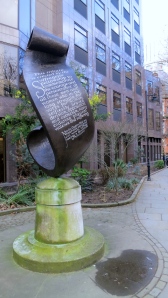This morning I scanned a few more recently rediscovered colour slides, of West Brompton Cemetery from February 2009.




As can be seen from these first four images, this was the time for daffodils to bloom. At least two of the stones in the second picture bear the name Hannam; single blooms have been laid on the cross on Nicholas Wenevitinon’s plot in the third, and beside the crucifix on the fourth. Perhaps one of my readers will be able to read the inscription on this last stone. (See John Knifton’s response to this, and koolkosherkitchen’s confirmation, in the comments below).
This is the memorial to Robert Coombes who features in this page from https://www.royalparks.org.uk/parks/brompton-cemetery/explore-brompton-cemetery/robert-coombes
‘Robert Coombes (1808-1860)
The fastest man on the Thames and the Tyne.
Coombes was one of the greatest professional oarsmen of his time. He began rowing when he was still a boy, working as a waterman carrying passengers on the River Thames.
 Thames watermen rowed passengers up and down the river, while lightermen carried goods and cargo. Both required great skill, strength and an intimate knowledge of the river and its tides. (Credit: Wikimedia Commons via Flickr)
Thames watermen rowed passengers up and down the river, while lightermen carried goods and cargo. Both required great skill, strength and an intimate knowledge of the river and its tides. (Credit: Wikimedia Commons via Flickr)
He started winning rowing races when he was in his late twenties, becoming English Sculling Champion three times. Though he was small and light, Coombes’s considerable rowing skill meant he could beat bigger and stronger men.
He competed individually but also had notable rowing success as part of a crew of four. Coombes’ team beat renowned rower Thomas Clasper and his crew on the River Tyne for the first time in 1842, and several times afterwards on the Thames.
(Credit: Illustrated Sporting & Dramatic News)
Coombes went on to coach teams from both universities competing in the Oxford and Cambridge boat race, leading Cambridge to victory twice. He stopped coaching when controversy arose over the use of professional (working class) watermen to teach the amateur (upper class) university teams.
 The Oxford and Cambridge Boat Race in 1841, a year after Robert first became involved as a coach. (Credit: Wikimedia Commons)
The Oxford and Cambridge Boat Race in 1841, a year after Robert first became involved as a coach. (Credit: Wikimedia Commons)
Despite his incredibly successful rowing and coaching career, Coombes died in poverty in Kent Lunatic Asylum in 1860. His impressive monument, topped with an upturned boat, was paid for by friends and members of the public. Many Thames watermen came to his funeral.
 In 1700, the men who rowed people and goods on the Thames joined together form The Company of Watermen and Lightermen. The Company, based at The Watermen’s Hall in the City of London, remains a working guild and is actively involved with the life of the River and those who work on it. (Credit: Steve Cadman / Wikimedia Commons via Flickr (CC-BY-SA))‘
In 1700, the men who rowed people and goods on the Thames joined together form The Company of Watermen and Lightermen. The Company, based at The Watermen’s Hall in the City of London, remains a working guild and is actively involved with the life of the River and those who work on it. (Credit: Steve Cadman / Wikimedia Commons via Flickr (CC-BY-SA))‘
(Garrulous Gwendoline’s comments below offer more information on Watermen and Lightermen)
This bas relief plaque commemorates
‘Samuel Leigh Sotheby (1805-1861)
The third and final generation of the Sotheby family to be involved with the famous auction house.
Samuel Leigh was the grandson of bookseller and auctioneer John Sotheby, who helped establish the celebrated auction house that still bears the family’s name.
John’s son Samuel expanded and rebranded the family business, then Samuel took on his own son, Samuel Leigh. Father and son worked well together. Samuel Leigh proved to be a good businessman, and was responsible for many of their finest catalogues. However, the company got into difficulties in 1825 and was declared bankrupt.
Samuel Leigh changed the company name to S L Sotheby in 1837 and, when his father died five years later, took on his accountant John Wilkinson as a partner. John was a great salesman, and Samuel produced beautiful auction catalogues. Between them, they rebuilt the business into the premier auction house for antiquarian books.
Samuel Leigh also edited and completed books begun by his father, and wrote and published his own work, including a volume on John Milton’s autographs. He was a great collector too, particularly of auction house and library catalogues, and the works of English artists.
Samuel Leigh died tragically and unexpectedly in June 1861. He was walking near Buckfast Abbey in Devon, when he fell into the River Dart and drowned.’ https://www.royalparks.org.uk/parks/brompton-cemetery/explore-brompton-cemetery/samuel-leigh-sotheby2
The Coldstream Guards are well represented in the military section. (For more information on this, see the link on Quercus’s comment below).


These last two black and white conversions feature one of the covered arcades and a sculpture I haven’t identified.
This evening we dined on Jackie’s tasty cottage pie; toothsome cauliflower, carrots, and cabbage, with meaty gravy. She drank Hoegaarden while I drank more of the Comté Tolosan Ruge.












































